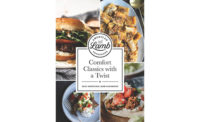 When the pandemic shut down restaurants, the lamb industry was concerned about the many lamb racks on hand which traditionally went to the foodservice market. The lamb industry soon discovered, however, that consumers were excited to buy these premium lamb cuts as well as economical cuts of lamb at the retail market.
When the pandemic shut down restaurants, the lamb industry was concerned about the many lamb racks on hand which traditionally went to the foodservice market. The lamb industry soon discovered, however, that consumers were excited to buy these premium lamb cuts as well as economical cuts of lamb at the retail market.
Consumers seeking more authentic and adventurous protein options purchased lamb for at-home meal preparation like never before.
While all meat sales grew in 2020 as more meals were consumed at home, lamb sales grew at a larger percentage than total meat sales overall, according to according to a lamb retail sales report developed from Information Resources Inc. (IRI) data that was analyzed by Midan Marketing and commissioned by the American Lamb Board.
Prior to (and at the start of) the COVID-19 pandemic, dollar sales of lamb and the meat department as a whole generally moved in lockstep. Beginning in the third quarter of 2020, however, lamb began to outpace the overall meat department. During the third and fourth quarters of 2020, dollar sales of lamb showed markedly larger percent increases from the same time period last year than dollar sales of meat overall.
The disparity in percent increase between lamb and the overall meat department continued through January 2021 and began to expand beginning in March 2021 with lamb seeing a 5.2.% increase while meat overall saw a 22.5% decrease.
As with dollar sales, the percent change in volume sales of lamb has historically been comparable to the percent change in volume sales of meat overall. In the wake of the COVID-19 pandemic, volume sales as well as dollar sales of lamb began to grow at higher percentages than meat overall.

In the third and fourth quarters of 2020, volume sales of lamb showed much larger percent increases than dollar sales of meat – often by double or triple.
This disparity in volume sales percent increase between lamb and the overall meat department continued through the early months of 2021 and appears likely to continue through much of this year.
In 2020, the lamb industry experienced an increase of 24.7% in dollar sales and a 17.7% increase in pound sales as compared with 2019.

Sales of lamb racks exploded during 2020, with retail dollar sales increases of 47.6% and 52.8% in volume as compared with 2019. During this same time period, ground lamb also showed significant increases – up 26% in dollar sales and up 23.7% in pound sales as compared with 2019.
Most importantly, lamb sales in 2021 continue to show growth even as restaurants are reopening.
Consumers gained kitchen confidence during COVID, and their willingness to try lamb and new lamb recipes increased. The American Lamb Board will continue to focus on educating new lamb consumers by sharing simple recipes, information about nutritional benefits, ease of preparation, versatility of cuts, and cooking techniques as well as information about how American lamb is raised.
While lamb sales to restaurants were greatly affected by the pandemic, demand is returning and the lamb market is tight on supply. While lamb has often been seen as a fine-dining protein, restaurant demand is shifting to include lamb menu items in fast casual, midscale and casual dining restaurants.
The American Lamb Board and Taziki’s Mediterranean Café are working together to introduce a new Taziki’s Lamb Burger, two patties of savory, seasoned ground lamb, topped with grilled peppers and onions, feta cheese and tzatziki sauce served on a grilled Kaiser bun.
Taziki’s Mediterranean Café began testing this new lamb addition to their menu on July 12 in select markets.
According to Taziki’s Mediterranean Café, lamb is one of their most popular protein options, and now their customers who are fans of lamb gyros or family feasts can experience American lamb in a new way.
The American Lamb Board will sponsor a consumer research study as well as a menu study to better understand the shifts in lamb use during the pandemic.
What we know for sure is that consumers discovered lamb during the pandemic and are ready for more.






